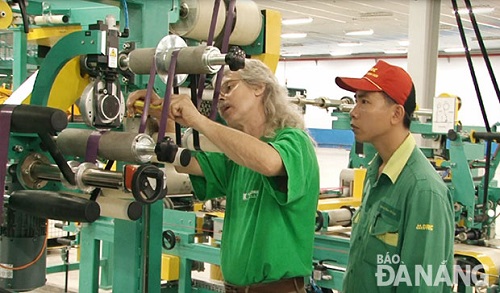Da Nang Rubber Company has successful year
Last year, the Da Nang Rubber Company (DRC) reached its year’s target of hitting 3.374 trillion VND in its industrial production value, despite its move into the Lien Chieu Industrial Park from Ngu Hanh Son District. DRC contributed 189 billion VND to the city’s budget, which ranked it 3rd among tax payers from the local industrial sector.
These positive results were mainly attributed to the company’s effective production activities and marketing strategies, especially taking full advantage of the production methods and technologies which the company has invested in over recent years.
 |
| Equipment being installed at DRC’s Steel Radial Truck Tyre Factory |
Over the past 5 years, apart from developing new facilities, the company has poured trillions of VND into upgrading its technologies and equipment in order to boost its production activities.
Also last year, DRC’s Steel Radial Truck Tyre Factory was built at a cost of over 2 trillion VND.
Most notably, superweight tyres used in the mining industry have become among the company’s key items and dominate in many Southeast Asian markets.
To date, the company’s products have been sold in 33 countries worldwide. Its key products are radial tyres, bias car tyres, motorbike and bicycle tyres and tubes, secondhand car tyres and technical rubber products.
Of special note, DRC is the first-ever company in the city to have successfully manufactured the OTR tyres. This product, with a diameter of 3.3m, has been recognised as the largest car tyre made in Viet Nam by the Viet Nam Guinness Book of Records.
DRC’s brand name has won the trust of customers both at home and in other Southeast Asian countries.
In 2014, the company’s brand name was voted one of Viet Nam’s top 50 prestigious brand names. In addition, it received the 2013 Viet Nam Gold Star Award. Most notably, the company’s products have been selected by the city authorities as one of the city’s key items during the global integration period.